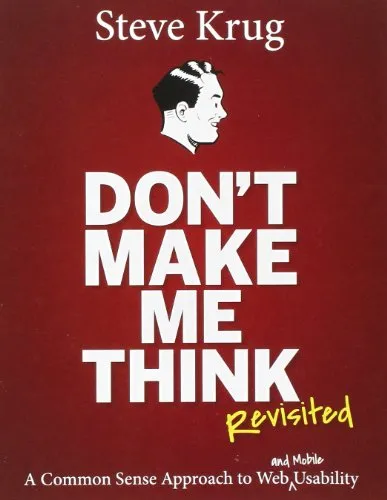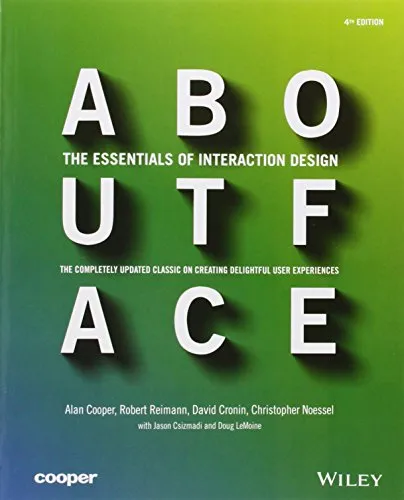Designing Social Interfaces: Principles, Patterns, and Practices for Improving the User Experience (Animal Guide)
4.5
بر اساس نظر کاربران

شما میتونید سوالاتتون در باره کتاب رو از هوش مصنوعیش بعد از ورود بپرسید
هر دانلود یا پرسش از هوش مصنوعی 2 امتیاز لازم دارد، برای بدست آوردن امتیاز رایگان، به صفحه ی راهنمای امتیازات سر بزنید و یک سری کار ارزشمند انجام بدینکتاب های مرتبط:
معرفی کتاب: طراحی رابطهای اجتماعی
کتاب "طراحی رابطهای اجتماعی: اصول، الگوها و روشهایی برای بهبود تجربه کاربری" اثر Christian Crumlish و Erin Malone یک منبع جامع برای درک نحوه طراحی رابطهای اجتماعی موفق است. این کتاب به مباحث اصلی در طراحی تجربه کاربری (UX) و وتعامل کاربری (UI) میپردازد و نکات کلیدی و کاربردی برای ایجاد واسطهای کاربری فراهم میکند که تجربه کاربری بهتری را ارائه میدهند.
خلاصهای از کتاب
این کتاب با تمرکز به نقش کلیدی که رسانههای اجتماعی در عصر دیجیتال بازی میکنند، راهنماییهای عملی برای طراحی Interfaceهایی ارائه میدهد که به کاربران امکان تعامل موفقتر و مؤثرتر را میدهد. از طریق مثالها و رویکردهای مبتنی بر الگوهای طراحی، نویسندگان توضیح میدهند چگونه میتوان تجربه کاربری را بهینهسازی کرد تا تعامل و مشارکت کاربران افزایش یابد.
نکات کلیدی از کتاب
- اهمیت understanding context در طراحی مؤثر Interfaceها.
- تأثیر Feedback loops بر تعامل کاربران و چگونگی بهبود آنها.
- روشهای تقویت اعتماد در طراحیهای اجتماعی و نرمافزارها.
- ضرورت رعایت اصول usability و accessibility در طراحی برای همه کاربران.
جملات معروف از کتاب
"یک طراحی بینقص نه تنها درباره ظاهر زیبا، بلکه درباره کارکردی بودن و تجربه احساسی است که به کاربران ارائه میکند."
چرا این کتاب مهم است؟
این کتاب به عنوان یک منبع مرجع برای متخصصین UX و UI و همچنین برای کسانی که به دنبال توسعه مهارتهای طراحی خود هستند، مطرح است. اهمیت این کتاب در ارائه راهکارهای عملی و مثالهای واقعی است که قابل اجرا در پروژههای مختلف طراحی هستند. با توجه به رشد روزافزون استفاده از platformهای اجتماعی، توانایی طراحی Interfaceهایی که بتواند نیازهای کاربران را به خوبی پاسخ دهد، از اهمیت بالایی برخوردار است. این کتاب به روشنی راههایی را پیشنهاد میدهد که میتواند منجر به ساختن نرمافزارها و وبسایتهای موفقتر و کاربرپسندتر شود.
Welcome to "Designing Social Interfaces: Principles, Patterns, and Practices for Improving the User Experience," a comprehensive guide that delves into the intricacies of creating engaging social interfaces. Authored by Christian Crumlish and Erin Malone, this book offers invaluable insights into the world of social applications, exploring the essential elements needed to create effective, user-centered designs. This introduction will guide you through a detailed summary of the book, key takeaways, famous quotes, and the significance of this work in the context of design practices.
Detailed Summary of the Book
"Designing Social Interfaces" explores the principles and patterns that are crucial for creating social applications with compelling and intuitive user experiences. The authors draw from their extensive experience in web design and user experience, presenting a blend of theory and practical guidance. The book unravels the complexities of social interface design by covering aspects such as user interaction patterns, social media strategy, and community-related design choices.
Throughout its chapters, the book provides a rich collection of patterns for social software and platforms, emphasizing how to leverage these patterns to create richer, more engaging interactions. Christian Crumlish and Erin Malone provide real-world examples and case studies, illustrating how these principles have been effectively applied across different platforms and user scenarios. Whether you are designing a new social media platform or refining an existing application, this book offers a treasure trove of insights to steer your project towards success.
Key Takeaways
- User-Centric Design: Understanding the needs and behaviors of your users is essential to create interfaces that cater to their social interaction needs.
- Patterns and Practices: Leveraging design patterns can simplify complex social interaction problems and aid in creating consistent user experiences.
- Community Engagement: Fostering engaging communities involves strategic planning and thoughtful design that encourages participation and collaboration.
- Iterative Design Process: Social applications require an iterative design approach that evolves through user feedback and empirical observations.
Famous Quotes from the Book
"Design is not just what it looks like and feels like. Design is how it works." - Steve Jobs
"Good design is a lot like clear thinking made visual." - Edward Tufte
Why This Book Matters
In an era dominated by social media and online interactions, "Designing Social Interfaces" stands as a crucial resource for designers and developers. It offers a structured framework for understanding and addressing the nuances of social interaction within digital platforms. By focusing on user experiences, this book helps bridge the gap between design and functionality, ultimately contributing to more inclusive and user-friendly social interfaces.
This book is not just for designers but for anyone involved in the development of social platforms—be it product managers, developers, or marketers. The insights within offer guidance to ensure that every aspect of the user journey is thoughtfully crafted, leading to stronger user engagement and satisfaction.
In summary, "Designing Social Interfaces" provides actionable insights and practical strategies essential for anyone striving to create meaningful social software. Its focus on design principles, coupled with real-world applications, makes it a standout reference for those dedicated to enhancing the ever-evolving landscape of social interactions.
دانلود رایگان مستقیم
شما میتونید سوالاتتون در باره کتاب رو از هوش مصنوعیش بعد از ورود بپرسید
دسترسی به کتابها از طریق پلتفرمهای قانونی و کتابخانههای عمومی نه تنها از حقوق نویسندگان و ناشران حمایت میکند، بلکه به پایداری فرهنگ کتابخوانی نیز کمک میرساند. پیش از دانلود، لحظهای به بررسی این گزینهها فکر کنید.
این کتاب رو در پلتفرم های دیگه ببینید
WorldCat به شما کمک میکنه تا کتاب ها رو در کتابخانه های سراسر دنیا پیدا کنید
امتیازها، نظرات تخصصی و صحبت ها درباره کتاب را در Goodreads ببینید
کتابهای کمیاب یا دست دوم را در AbeBooks پیدا کنید و بخرید
1319
بازدید4.5
امتیاز50
نظر98%
رضایتنظرات:
4.5
بر اساس 0 نظر کاربران
"کیفیت چاپ عالی بود، خیلی راضیام"
Questions & Answers
Ask questions about this book or help others by answering
No questions yet. Be the first to ask!













